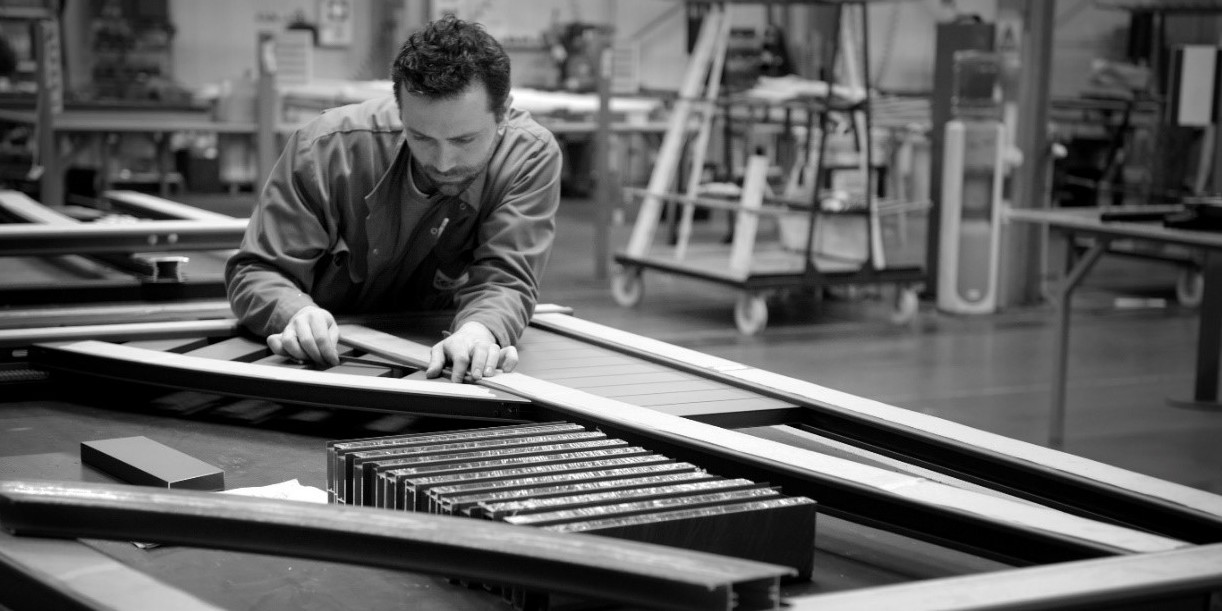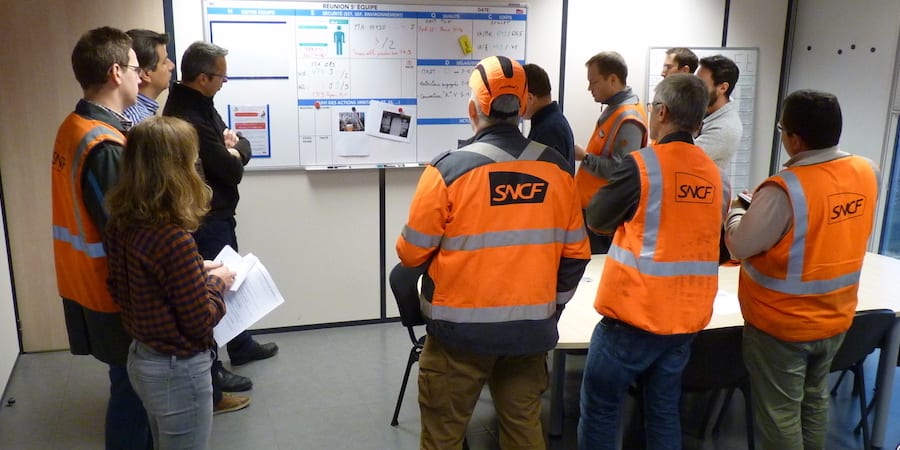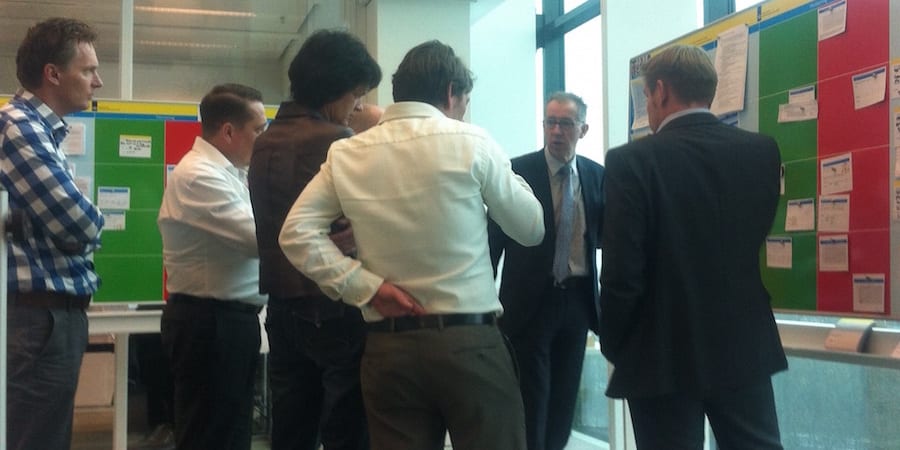
The gateway to success
NOTES FROM THE GEMBA – By introducing flow in its processes and transforming its approach to managing the business, this French manufacturer of fences and gates is building a competitive advantage.
Words: Catherine Chabiron, lean author and member of Institut Lean France
The plant and offices I am visiting today overlook the Atlantic. You can’t really drive any further west in France. Welcome to Cadiou, in Brittany, a family business making fences and gates for private customers, distributed through a network of DIY retail chains and local installers.
Today, Emmanuelle Legault, who co-manages the business she inherited from her parents with her husband and her brother-in-law, is hosting a masterclass on levelled pulled flows. She firmly believes that introducing takt time in the plant and levelling the work in production literally saved her from going mad and her business from having to pay very hefty penalties.
As the team of co-managers took over from Emmanuelle’s parents in 2007, Jean François, in charge of Sales, managed to sign up for 50% more turnover with two major DIY retail brands. The management team was soon running all over the place to catch up with sales and production issues, pushing orders up the priority lane when customers became too vocal, dealing with angry installers or relabelling already delivered finished goods.
WRONG ASSUMPTION
“At the time,” Emmanuelle says, “we all believed that to reduce unit cost we needed big, expensive machinery and large batches. The more we could pack into a batch, the better. We had not yet realized that this also meant significant waiting time for our customers and a dependency on expert hands on our part to set up and maintain the machines.”
The story of the cutting machines and their operators is interesting. At the time, Cadiou’s carpentry production entailed cutting and assembling (they have since integrated the activity of painting). The cutting part was done by sophisticated machines, located in a separate plant, where workers soon realized their unique expertise and started a war with management on whether or not any new task was part of their job description. At that moment in time, management was moving fast to build growth, trying to deal with the variability of orders as well they could, and barely listened to operators. Until, in 2010, they went on strike.
FAST GROWTH, BUT AT WHAT COST?
That was not fun. As she and her co-managers took over the family business, Emmanuelle had dreamed of turning it into a modern, show-piece company. However, while growth was there, serenity was not. She had lived similar situations as a child, when her father would just as well voice his fear about the company lacking work or, during more successful times, complain because there were too many orders. Both situations are stressful and extremely uncomfortable. Add this to the fact that most garden owners start contemplating the idea of changing a fence or gate the moment they start using their lawnmower in April (and expect delivery during the summer) and you will have a good understanding of the seasonality and uncertainty associated with the business Cadiou is in.
Then, one day, one of the company’s major clients – a retail chain – called to say that the service rate was at 50% and that they would consequently start to charge penalties.
Térence Carpentier, in charge of operations at Cadiou, and Emmanuelle are now taking the masterclass group for a tour of the plant. As we follow the flow, I start to understand the magnitude of the issue: the main product flow (aluminium based) is an array of around 25 tables where carpenters are manually assembling gates and fences – each a specific order in terms of size, colors, and finish. No one-piece flow here, just pure make-to-order, with each carpenter receiving the parts from Cutting and performing final assembly.
“Anybody can make a plain gate in aluminium. So, if we want to survive, we need to offer diversity and choice. We started with 10 colors in our palette, we are now moving to 25,” Emmanuelle chips in.
After contracting a local designer, Cadiou has also started to offer laser-cut decorations on fences, gates, balcony railings or windbreaks, which customers can choose from in a catalogue (have a look at the process here). This helped increase the turnover (more than €67 million today) and the EBITDA, but it didn’t help production when the company decided to move away from the traditional white fence.
Térence was the first to suspect that levelled pulled flows could be the solution to their problem: he particularly liked the “levelled” part of the concept. So did Emmanuelle, who was tired of the peaks and troughs that were challenging production. Cadiou’s problem, however, was the make-to-order process: how do you organize pulled flows at takt time when 70% of your orders are customized?
They took the problem to Philippe Grosse, a well-known levelled pulled flow expert in France, at the end 2012. By May 2013, together, they had not defined a textbook levelled pulled flow but something close to it that allowed Cadiou to at least stabilize the process. All the stakeholders – from management to operators – were trained and the decision was then made to launch the new approach at the very beginning of the 2013 sales peak season.
Production experienced immediate relief. “With levelled pulled flows, we can actually see the customer in the plant. We can see the level of our production performance and we don’t need the ERP to do so. We can spot abnormalities, make decisions, and escalate if need be. We can test out solutions, check them and adjust them,” says Emmanuelle.
This is where lean management truly helps. Morning routines and management gemba walks offered operators new opportunities to voice their issues and concerns. As these were identified and tackled, work conditions improved. Conflict and reliance on the Unions were no longer the only way to discuss working conditions: a solid Top 5 in the morning turned out to be a far more efficient outlet for delivering concerns. Pulled flows also highlighted the need for smaller batches and big machines were eventually replaced by smaller, simpler, more flexible equipment, which had the added benefit of not being as expert-dependent. This also contributed to far more relaxed working environment.
JIT IN A MAKE-TO-ORDER PROCESS
The implementation of flow started with Sales & Operations Planning (S&OP). While Cadiou was regularly updating a production plan, no one had tried to understand how future sales would develop. Nobody even suspected this could be done. Using past sales data and injecting assumptions on the new products or shifts of customers, the team progressively came up with a medium-term plan of their upcoming sales.
The seasonality they confirmed led them to a bit of lean thinking.

Could they convince their customers to purchase outside of spring and summer? Difficult, as this is a B2C activity: the end customer probably won’t be willing to change her buying habits and, even if she is, she will be unlikely to re-purchase soon.
Could the team develop new “winter” products, then? This is a long-term challenge and not an obvious one in this line of business. For now, Cadiou has started to develop a range of shutters (just to provide you with an example).
They were consequently left with only two options in the short term. The first option was to make the most of the lower activity in winter to produce some of the high runners.

The alternative was to adjust the workforce to cope with the peak periods.

They actually chose a mix of the two solutions (and accepted a bit of additional stock in winter). On the workforce side, this led Cadiou to work on multiskilling: they have now started an internal school where potential recruits are trained for a month before they move to production.
“We had tried on-the-job training before, but this seriously hampered the productivity of our most senior workers,” Emmanuelle says. “The school is definitely a far better solution: the S&OP confirms our recruiting needs, we train them between November and January, and 92% of the trainees are confirmed at the end of the training and offered a 6-to-10-month job.”
The next step was to get into the details and start levelling production over the week, day by day (fixed production effort). But here, again, the team stumbled over the problem of the work content, which can vary a lot from one order to another. If 80 orders are placed each day, you will have to mix a sequence of low-, medium- and high-work content jobs. Levelling production also meant that some orders would be moved forward, compared to the expected deadline agreed upon at the time of the order, to try and spread out the effort. As of today, by the way, Cadiou is tracking both the service rate and the advance rate (orders delivered earlier than scheduled with the installer). Advance delivery is not a small issue given the size of the fences and gates they work on!
Lastly, the team had to decide whether they would prepare one Kanban per actual order or use generic Kanban cards to start with (in other words: a generic Kanban would just signal one order at takt time within the flow, with no specifics). The latter solution had two advantages: it could be introduced quickly and would immediately make the takt time visible on the heijunka board and on the launchers.
This is how they started in mid-2013 and how they still operate today. As we tour the plant, Emmanuelle and Térence show us the process, starting with the heijunka board, filled with generic withdrawal Kanban cards at takt time for the day, on each of the major product flows (aluminium, PVC, etc).

Generic withdrawal Kanbans for the scheduled time slot are picked up by Logistics, who collects finished products from each of the assembly cell shop stocks and takes them to Packaging and Shipping.

The generic production Kanban found on the finished product in the shop stock is put by Logistics on the production cell launcher.

Logistics will then use the production Kanban on the launcher as a signal to go and collect a kit of cut parts from Cutting, ready to be assembled.

Each kit of cut parts comes with its own production Kanban that is in turn put on the Cutting launcher.

And this is where a Kanban on the Cutting launcher ties up with the order file containing the actual specs, picked up from a pile, in FIFO. High-work content alternates with low-work content so that the takt time of the day can be respected.

All the above was of course implemented with live Paretos of issues, problem-solving boards, morning Top 5 routines, escalation rules if Kanbans overflow in the red area of the launchers, red bins (or rather red carts) should a part or finished product be damaged. Cadiou has also designed a process for sending back problems to whoever generated them (for example a mistake in design) through a letterbox that is collected every day and redistributed to each stakeholder.

Some interesting metrics: while they handle two to three times more volume, their lead-time within the aluminium workshop (70% of the sales) is down to two-and-a-half days, six times shorter than before pulled flows were introduced. In 2019, productivity has doubled versus their starting point (and increased by 30% versus 2018). Thanks to the team’s kaizen effort, scrap went down from 28 to 11%. They are targeting 6%. The service rate with the DYI retailers that threaten them of charging late-delivery penalties shot up from 50% to 97%.
And, by the way, when launchers are empty, this is time for kaizen or maintenance.
WHAT ELSE DID THEY DO?
Cadiou was so convinced that levelled pulled flows are the way forward that they introduced them in all the other production flows and in the ordering process (Order data entry and Design). The latter is supported by a workflow tool that highlights where the order stands and how they fare on the lead-time.
After reducing the lead-time sixfold on cutting and assembly, the team was stuck on any further progress because of the long painting lead-time (this was sub-contracted and it took an average of two weeks, mainly due to the batch size). This is when they decided to learn the painting trade and build a painting line. Levelled pulled flows were implemented in the new plant as well and the painting lead-time soon dropped from 12 days to 12 hours. With pulled flows, they only paint the needed quantity and have consequently reduced unnecessary inventories and the associated square meters.
“Now that we paint ourselves, we see all the faulty materials we were sending our supplier,” says Emmanuelle, “and this has opened up new kaizen opportunities.”
Emmanuelle is a firm advocate of levelled pulled flows, as they provide production stability (constant effort) and introduce the customer pace (takt time): “The heijunka board is an opportunity to see where we stand at all times. It represents the customer,” Emmanuelle says. The gain on the customer lead-time is also a clear competitive advantage. She gives the example of railings: a major construction company recently encountered a problem on one of their building sites and made a last-minute purchase of railings, because none of Cadiou’s competitors could deliver those in less than nine weeks. What Emmanuelle is hoping now is for them to recognize that, in addition to the lead-time, they also find their railings easier to install (they worked extensively on the design with the installation in mind) and shift part of their purchases to them, even though Cadiou’s products are more expensive.
WHAT ABOUT TOMORROW?
Cadiou’s management team is going on a gemba walk around the plant once a week, and this helps them to indentify new improvement opportunities. We discuss at length some of them as the day draws to an end. For example, shouldn’t they reduce the size of the production cell in the main aluminium flow to increase the autonomy on kaizen? Is their process now mature enough to move away from generic kanban cards and envisage actual product specific kanbans, with possibly different production flows depending on the work content? As the lead-time is further reduced, the tension between production stability (levelling) and customer satisfaction (no advanced deliveries) will increase, and this may require a finer understanding of product families and of associated work contents and flows.
Another improvement track is related to materials. Only the day before my visit, the team discovered that 12 items represented 58% of their sales and that the most consumed one is moved five times before actually being used.
Cadiou is also very committed to becoming a greener organization (they have reduced the PVC offer for that reason) and is engaged in recycling. For example, packaging is a concern because it has to be disposed of and cannot be re-used. Sustainability is but one of the topics the team is encouraged to develop kaizen on for annual Initiative Awards.
Emmanuelle leaves us with an interesting and very direct question: “Can we really say we are on a lean transformation if we haven’t implemented Just-in-Time yet? Levelled pulled flows are an unavoidable step if we want to face our real problems.”
THE AUTHOR

Read more


CASE STUDY – The turning point in this Colombian construction company’s transformation came when they started to embrace lean as a culture rather than just a set of tools.


NOTES FROM THE GEMBA - We follow the author on a visit to a train maintenance center in France. Through practical examples and pictures from the gemba, she explains how the center is transforming itself.


FEATURE – In this article, the author reflects on how his understanding of lean thinking evolved over time – as did the way he defined it.


FEATURE – The theory of hoshin kanri is clear, but how can you adapt it to a government organization structured in departments where making A3s is not a daily practice? A Dutch ministry shares its experience.

